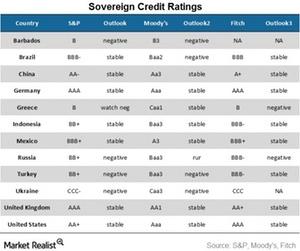Russia’s sovereign credit rating downgraded to junk
Russia’s sovereign credit rating now stands on par with countries such as Turkey and Indonesia. The oil price crisis isn’t helping matters.
Feb. 2 2015, Updated 12:06 p.m. ET

Standard & Poor’s downgrades Russia’s sovereign credit rating to junk
On Monday, January 26, global credit ratings agency Standard & Poor’s, or S&P, downgraded Russia’s sovereign debt to junk level. S&P lowered its long- and short-term foreign currency sovereign credit ratings on the Russian Federation to non-investment grade BB+ from investment grade BBB-.The outlook for long-term ratings is negative. Russia’s rating now stands on par with countries such as Turkey and Indonesia.
The news of the downgrade caused a 7.4% slide in the VanEck Vectors Russia ETF (RSX) and a 6.3% decline in the iShares MSCI Emerging Markets Eastern Europe ETF (ESR). The RSX portfolio is invested up to 84% in Russia, while ESR’s portfolio is invested up to 61.17% in Russian equity.
Fitch and Moody’s still consider Russia investment grade
The country last had a non-investment grade rating in 2004, when it was still recovering from the financial collapse of the 1990s. Recently, Moody’s and Fitch have also cut their ratings for Russia. Both these rating agencies still rate Russia in the investment grade category, just at the lowest possible level and with a negative outlook.
On January 9, 2015, Fitch Ratings downgraded Russia’s long-term foreign and local currency issuer default ratings to BBB- from BBB, one notch above junk. The agency maintains a negative outlook for the Russian economy. Soon afterward, on January 16, 2015, Moody’s downgraded Russia’s government bond rating to Baa3, two notches above junk. Moody’s also placed the rating on review for further downgrades.
Rating downgrade adds to Russian woes
The rating downgrade is the latest roadblock to growth in Russia. The Russian economy is already struggling to survive the collapse in oil prices, which has negatively impacted funds including the United States Oil Fund (USO), the United States Brent Oil Fund (BNO), the SPDR S&P Oil & Gas Exploration & Production ETF (XOP), and the iShares Dow Jones US Energy Sector Index Fund (IYE). The depleting strength of its currency and the Western sanctions imposed that are limiting investments and fueling inflation in the economy, aren’t helping matters.
Will Russia be shut out of global capital markets?
Russia is increasingly finding itself shut out of global capital markets. The year 2014 saw persistent capital outflows, with a total of $152 billion funds being pulled out of the economy in just one year. In comparison, the 2009–2013 average was $57 billion.
If oil prices don’t correct and Western sanctions aren’t lifted, the situation may get worse for Russia—to a point where the country could run out of cash.
The ratings downgrade to junk is another major impediment to Russia’s ability to access international financing. Next in this series, we’ll take a look at the reasons S&P gave for downgrading Russia’s rating.
